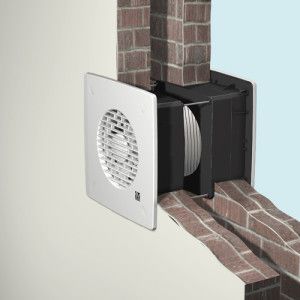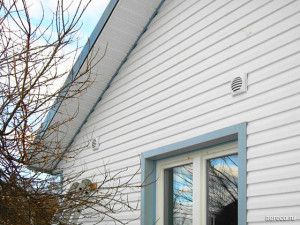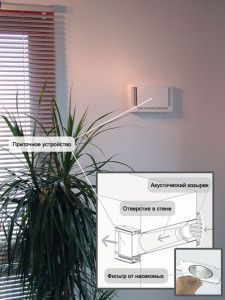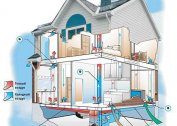One of the most common options for removing the ventilation pipe from an apartment or private house is a hole in the wall. It is used for inflow and exhaust air. Most often, the ventilation of the bathroom or kitchen is pulled through the wall to the street. Read how to make a ventilation hole in the wall, what tools to use and how to isolate the resulting hole without breaking the thermal insulation.
Wall ventilation patterns
In apartments or private houses, the most rational arrangement of ventilation through the wall is:
- with natural traction;
- with mechanical outflow;
- combined.
Natural ventilation is based on the draft principle. Air moves due to the difference in pressure and temperature inside the apartment and beyond. Such a system is independent of energy sources and is a structure of air ducts and openings, usually exiting through the walls.
Natural ventilation was widely used in the construction of old high-rise buildings, in modern buildings much less often.
One of the problems encountered during its operation is the lack of air flow. It is understood that fresh air enters the premises through the cracks between the window sashes, open windows. However, modern windows provide almost complete sealing. Therefore, residents solve the problem on their own, pulling ventilation through the wall to the street, installing supply air valves.
Household hoods also often work poorly, but not all apartments can make ventilation passage from the bathroom through the wall. It is much easier to build ventilation in the wall of a private house. It is advisable to design the ventilation passage through the wall in advance, linking it to all other structures.
Mechanical or natural?
When planning ventilation in an external wall, determine the system. One of the most important indicators of air exchange are speed and temperature.
Apparently this is why people feel worse in rooms with fans. But in some cases, mechanics are indispensable. For example, if it is not possible to make wide exhaust ducts in the outer wall for exhaust ventilation. The higher the speed of the air flow, the smaller the cross section of the ventilation duct. Therefore, mechanical ventilation is often installed in the outer walls. It is more advisable to mechanically induce large-area premises.
Comfort is achieved at a lower speed of movement of air masses. The speed of air movement in natural ventilation in the wall of the apartment is not more than 1 cubic meter per hour, while with mechanical ventilation it can reach 5 cubic meters per hour.
Wall ventilation inlets
Natural ventilation will work satisfactorily if you place a supply valve on the opposite wall from the exhaust outlet.
Supply valves for the passage of ventilation through the wall are made of PVC of various models and shapes:
- rectangular;
- oval;
- round.
Places of installation of ventilation in the wall:
- between the windowsill and the battery;
- in the casement of a plastic window;
- near the window, as close to the ceiling as possible.
If ventilation is led outside through the wall, in regions with cold winters, icy air will penetrate through the valve. Perhaps even icing of an adjacent section of the wall.
To avoid trouble, make a ventilation pass through the wall above the radiator.
Cold air will first be warmed up by the battery, and only then penetrate into the room.
Supply valve installation
Installation of ventilation in the wall is not complicated, but requires accuracy:
- On the wall with a pencil, indicate the location of the valve;
- How to make a hole for ventilation in the wall: a puncher with a special nozzle. The diameter of the hole is about 60 mm. Make a hole with a slope on the street for approximately outflow of condensate and precipitation;
- Pass the duct into the channel. Some models are sold already insulated. Others are insulated independently using mineral wool. She carefully lay all the voids between the duct and the wall. Fill the remaining slots with foam. In places of lack of insulation condensation will appear;
- Now you need to make markings for attaching the housing and attach it with dowels or screws;
- Put on a protective net on the outer cap, and a cover on the inner one.
Depending on the design, the valves can be equipped with filters, plugs and other devices. But regardless of the "tricked out" installation procedure is the same.
Exhaust devices in the walls of houses
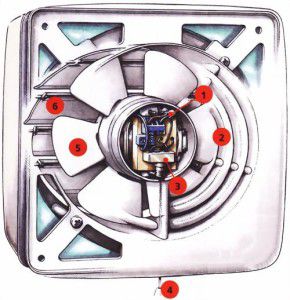
In some cases, it is more convenient to resort to mechanical exhaust air removal, that is, install exhaust ventilation through the wall to the street. The main component of the system is an exhaust fan. It is built into the exhaust hole in the wall and perfectly performs its functions. As household axial models are presented. Some of them are equipped with blinds that prevent back draft.
The fan can be started manually or automatically at the command of a humidity sensor. The most advanced are equipped with a timer that starts the engine in a given mode.
How to remove ventilation through the wall is an important issue, but first you need to calculate the characteristics of the equipment:
M = O x B,
Where M - fan power,ABOUT - the volume of the room, (to get it, multiply the length, height and width of the room),AT - air exchange depending on the destination.
Air exchange rates:
- for the kitchen 15 times;
- for toilet 8 times;
- for a bathroom or shower room up to 20 times.
The best place to install the fan in the wall of a private house is on the opposite side of the source of clean air, but not too close to it. At the top of the wall.
-
To install an exhaust fan in the wall of the apartment, you need to drill a round hole with a drill and a pen hole drill.
- The coupling, which is included in the kit, is inserted into the finished hole.
- If a square hole is required for the selected fan model (rarely), a rotary hammer with a spatula is used.
- Next, markings are made for attaching the fan. He is screwed to the wall on the expansion bolt shields.
- From the side of the street, the gaps between the pipe and the wall are thoroughly foamed.
- A non-return valve is installed to prevent cold air from entering the room when the fan is off. Some fan models have their own check valve.
- After the ventilation is led out through the wall, a decorative grille is mounted on the outside.
Fans are connected to the power supply through fusible fuses, which are installed in the switchboard.
If you doubt your own knowledge of electricians, invite a professional professional to connect the fan. And to help the brave, our video:
